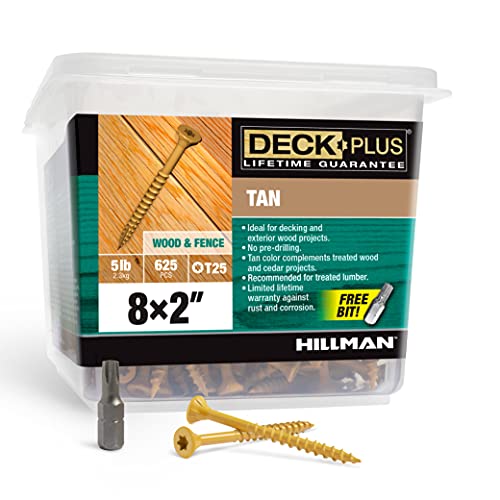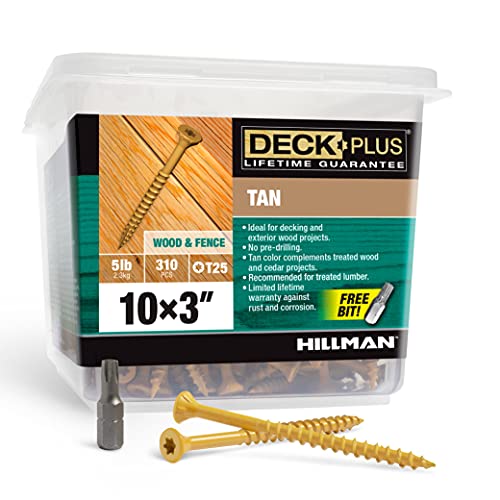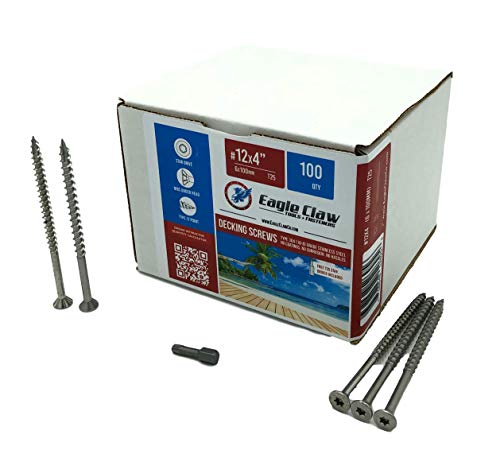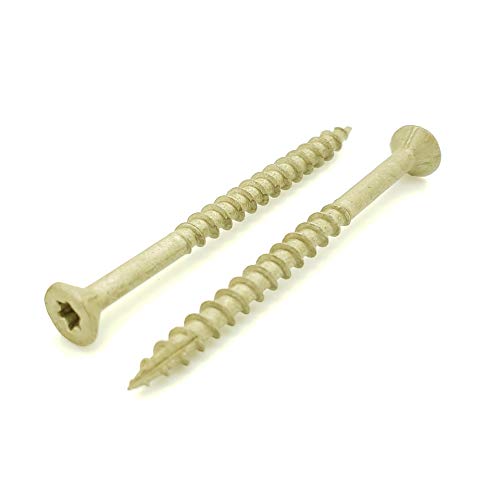Best Deck Screws for Pressure Treated Woods To Build a Perfect Deck
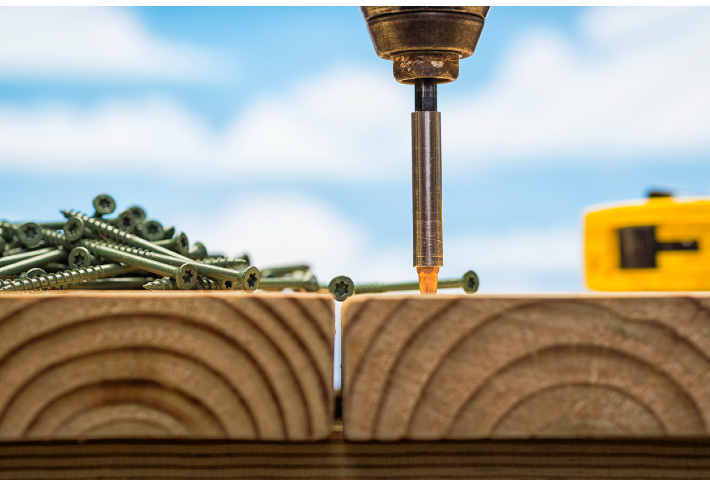
Developing a deck requires a lot of preparation and understanding, whether you’re a pro or a do-it-yourselfer. To guarantee that the project is structurally solid and will survive for years, it is important to choose the appropriate material for the task. Sadly, individuals damage the integrity of the deck by not choosing the best deck screws for the various elements of construction due to a lack of understanding or a desire to save money. Screws used in deck building must be able to endure the weather, structural loads, and the caustic nature of natural and chemical wood preservatives. Galvanized, ceramic coated, or stainless steel screws are the best corrosion-resistant fasteners for pressure-treated cedar or redwood. We will walk you through how to pick the best deck screws for pressure treated woods in 2023 while building an outdoor construction or deck in this article.
- Best Overall: Power Pro Wood Screws Shop Now ➔
- Runner Up: Deck Plus Wood Screws Shop Now ➔
- Honorable Mention: Hillman Fasteners Deck Screws Shop Now ➔
- Contender: Eagles Claw Fasteners Deck Screws Shop Now ➔
- Also Consider: Snug Fasteners Deck Screws Shop Now ➔
The Best Deck Screw for Pressure Treated Wood You Can Buy In 2023
Best Overall
For decking and outdoor wood tasks, the Power Pro Wood and Deck Screw are ideal. Because it is composed of high-quality steel and has a corrosion-resistant coating, it is strong and long-lasting. The screw includes a no-split twist shank design, which gently reshapes the hole to decrease driving friction and wood splitting. This design reduces wood splitting by 75% compared to other approaches used in standard wood screws. The screw is made using a no-strip star drive mechanism that provides 6 points of contact to optimize drive torque and prevent splitting. Countersinking blades, on the other hand, allow it to cut precisely completed holes by moving wood fibers away from the surface and sealing them.
Pros
- Drilling is simple without the requirement for pre-drilling
- Engages faster and more effectively than conventional screws
Cons
- Some consumers have expressed dissatisfaction with the quantity
Runner Up
The deck plus screws are one of the best deck screws for pressure treated wood and are ideal for different uses. It has an abrasive threaded construction that resists rust and stains, increasing its longevity. Furthermore, it is made of steel, which makes it quite durable. The screw has a star drive construction that minimizes spin-outs. Drilling is also simple and quick, thanks to the non-slip start drive head.
Pros
- Corrosion resistance is a feature of the screw
- There are no cam outs with this screw
- Drilling may be done smoothly and correctly
Cons
- The square drives soon wear out
Honorable Mention
The star drive design of the Hillman Fasteners Deck Screw ensures that it performs admirably. The mechanism aids in the transfer of torque and the prevention of cam outs, both of which are desirable qualities for your project. This screw will perform admirably in the many tasks you’re working on. The screw is robust and long-lasting, thanks to the steel and corrosive-resistant material it is made of. You may use it for outside tasks without worrying about the weather ruining your work. The screw’s head is specially engineered to give a smooth and uniform finish. It features countersinking nibs that are perfectly aligned with the wood surface.
Pros
- The star drive aids thrust transfer and prevents cam outs
- The screw’s covering substance protects it against rust and corrosion
Cons
- Once the screw is pushed into the board, it is difficult to remove it
Contender
For all coastal, wet, and outdoor situations, the Eagle Claw Stainless Steel Deck Screw delivers exceptional performance. It may be used in fences, decks, railings, jetties, and pathways, among other things. No more unsightly rust spots on your outside timber constructions, thanks to the screw’s exceptional corrosion resistance. The screw’s stardrive head makes it simple to drive into wood. It also prevents cam-out, which protects and extends the screw’s life.
Pros
- The screw is highly corrosion-resistant, preventing rust and stains on your wood projects
- Multi-purpose nature makes it ideal for a fence, decking, and other outdoor and wet environment applications
Cons
- Pre-drilling is recommended by the manufacturer, especially for thick wood and hardwoods
Also Consider
The Deck Screw offers a long-lasting hold thanks to its robust cutting thread. Because it is made of stainless steel, it is also quite durable. The screw’s exceptional corrosion-resistant ultra-guard coating makes it robust and long-lasting. You will also benefit from the bugle-shaped head with nibs, which provides improved head concealment. Your task will be simple and straightforward with this screw. It has a star drive configuration that makes installation a breeze.
Pros
- Enables rapid and simple installation
- Has a high corrosion resistance
- The screw’s bugle head is nicely camouflaged
Cons
- Users have expressed dissatisfaction with the number of screws included in the box
Best Deck Screws For Pressure Treated Woods Buyer’s Guide
Circular saws, tape measures, power drills, and a variety of other instruments are all utilized during deck building. These instruments are vital in their own right, and none of them are more important than the others since they complement each other. Screws are essential for connecting deck boards, and it’s especially important to do the screw job right if you are working with pressure-treated wood that includes chemicals. The best deck screws for pressure-treated wood are designed to provide optimal performance. The appearance of your completed product is mainly determined by the deck screw you use. Some screws are forceful, and if you drive them into the woods, they may break your boards, which may be costly in the long run. As a result, you will need to know a few facts regarding the screw you will use for your project.
What Are the Types of Deck Screws for Pressure-treated Woods Available?
In the broad category of screws, the deck screw is also a kind. Deck screws can also be classified based on thread, head, tip, drive, substance, and coating. However, we are going to tell you all you need to know about the deck screw right now.
According to head type
Screws used in deck building must be able to endure the weather, structural loads, and the caustic nature of natural and chemical wood preservatives. Coated, ceramic plated, or stainless steel screws are the best corrosion-resistant fasteners for pressure-treated cedar or redwood.
According to material and coating
Screws can be constructed of a variety of materials, including stainless steel, iron, and other metals, according to the material and coating. Deck screws require a lot of coating, especially when dealing with pressure-treated timber. The stainless steel polish is excellent, as is the ceramic coating. Additionally, other high-quality coatings are a possibility, but not galvanized coatings, since some galvanized coatings may be harmed by pressure-treated wood.
According to the thread and tip
Deck screws often have coarse threads, which are suitable for decking. The tip of the screw is also an essential consideration. Some screws have a Type 17 point (Self-drilling), which is the preferable option.
When Installing Wood Decking, What Size Screws Should Be Used?
The screw should sink 1 inch or more into the frame material. If the screw will be used on frame members and will have to sustain weight, select a bigger gauge
Deck framing
Bolts are commonly used to attach the deck’s rim joists to the posts and each other, although large diameter screws known as lag screws can also be utilized. A lag bolt used to join a 2-inch board must be at least 4 inches long. Similarly, because the railing is a safety element that may have to sustain weight in an emergency, 1/2-by-6-inch lag screws should be used to secure railing posts to the rim joist. Joist hangers are commonly used to join lateral joists to the rim joist; 6-gauge 1-inch screws are acceptable for this.
Decking and stairs
Different regulations apply to specialty decking materials. Ipe decking, for instance, is exceptionally hard and should be fitted using 10-gauge screws with tiny heads that may be inserted into the surface into predrilled pilot holes.
This video from The Honest Carpenter will help you figure out what size screw to use for each task:

What Are the Different Materials Used To Make Deck Screws?
You won’t have to pick the substance of your screws because they are bought for a specific purpose, and the makers have chosen the right steel or alloy and treatment to give them the greatest qualities. Thus, phosphate wood/agglomerate kinds, zinc-plated wood screws, stainless steel decking screws, and so on. The cheapest screws should be avoided since they are likely to be fragile and badly handled.
Bichromated
Corrosion resistance is moderate (provided screws are high quality). The cheapest are prone to losing their surface treatment, corroding as a result, and breaking when over tightened. They are yellow in color and lose their special covering when chipped.
Zinc plated
The quality of the treatment and the forces the screw is exposed to while in use determine whether it is zinc-plated or not.
Phosphated
The color is black. These screws are fairly robust and resistant to corrosion.
Chrome plated
Chrome plating has the same look as zinc plating and is just as durable.
Brass
Brass is mostly used in interior design, primarily in cabinets. Brass is prone to verdigris and has low corrosion resistance. Because these screws have not been treated, they are inappropriate for a variety of applications.
Stainless steel
It is ideal for usage outside. Stainless steel is long-lasting and, by definition, corrosion-resistant.
Variable proportion alloys
Variable proportion alloys gain from surface treatments (hydrolysis) according to the screw’s use.
What Happens if You Use Cheap Deck Screws for Pressure-treated Woods?
Another significant factor in evaluating when choosing the best deck screw brand is the quality of the screws. Don’t worry, since here’s what may go wrong if you pick subpar options.
When you buy low-quality fasteners, there’s a good chance they won’t keep the components together for long. It doesn’t matter how beautiful your deck is if the locks that hold it together aren’t suitable for your needs. Even a minute difference in diameter between the holes you create and the size of the screw you purchase may cause the screw to separate. As a consequence, making sure your screws are properly aligned with their requirements is important.
Another issue could be if the screw cap cracks. Because of the inferior quality of the material used in production, the screw may fail to bear the weight and break off, causing your deck to indent in certain areas. Furthermore, a faulty screw may break during the setup process. This is why only the strongest and longest-lasting screws should be used.
A low-quality screw may not endure wear and tear. If not for lack of strength, a crack or creep in the screw may cause it to break off in the middle. This could be due to the fact that it has been keeping the components together for a long period. For your deck to survive long enough, the screw must not only be sturdy but also made of lasting material.
People Also Asked
What is it about screws that carpenters prefer over nails?
When it comes to decking, the majority of carpenters choose screws. While nails aren’t very brittle, they can flex when put under stress Screws, on the other side, are always one step ahead. When the wood expands, they perform a much better job of keeping the joint together.
When it comes to deck screws, how deep should they go?
Deck screws should be inserted one inch into the board. Any more than that, and you’re risking splintering the board. The ideal practice is to set your drill to the lowest setting possible so that you have total control.
Is there a difference between wood screws and deck screws?
They do the same thing, yet they’re not the same. And besides, wood screws are generally used to join layers of wood securely. Deck screws, on the other hand, are designed to be used outside. Their principal material, copper or hardened steel, ensures that no corrosion occurs.
Is it necessary to pre-drill deck screws?
Pre-drilling screws is something you should always do. You may simply avoid wood splitting by doing so.
Article Contributors
The Woodsmith Review Team’s product reviews and in-depth guides are here to help you choose the best tools and gear to build great-looking projects confidently. Woodsmith is reader-supported: When you buy through links on our site, we may earn an affiliate commission. Large language models (like Artificial Intelligence) may have been used in the research and creation of the content.
Inquiries regarding specific articles or product testing should be sent to aimperiapt@gmail.com


